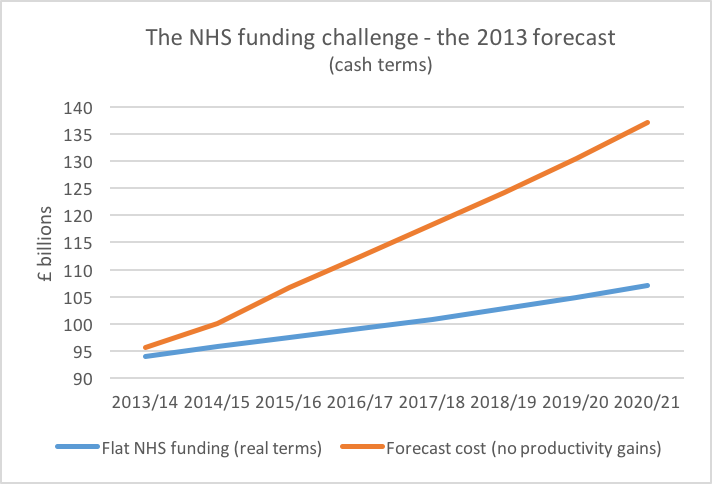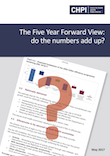 NB. This is the Appendix to the report: The Five Year Forward View: do the numbers add up? by Vivek Kotecha.
NB. This is the Appendix to the report: The Five Year Forward View: do the numbers add up? by Vivek Kotecha.
NHS Five Year Forward View spending gap forecast
Figure 1 shows the original spending gap forecast by NHS England in 2013. ((NHS England (2013a). The NHS belongs to the people: A Call to Action. Online. https://www.england.nhs.uk/wp-content/uploads/2013/07/nhs_belongs.pdf (accessed on 6th February 2017).)) ((NHS England (2013b). The NHS belongs to the people: A Call to Action – The Technical Annex. Online. https://www.england.nhs.uk/wp-content/uploads/2013/12/cta-tech-Annex.pdf (accessed on 6th February 2017).)) It is in cash terms, i.e. not adjusted for inflation (more cash is given to the NHS every year – the blue curve rises – but health cost inflation wipes out the benefit – the NHS’s real spending power remains flat). In cash terms the forecast gap between what the NHS was to get and what it was projected to need over the eight years from 2013 to 2021 adds up to a total of £123bn.

Figure 1. The NHS spending gap as forecast by NHS England in 2013 ((NHS England (2013a). The NHS belongs to the people: A Call to Action. Online. https://www.england.nhs.uk/wp-content/uploads/2013/07/nhs_belongs.pdf (accessed on 6th February 2017).))
The NHS Spending Review – further analysis
Later analysis has shown that the announced £10bn figure of additional funding for the NHS included funding transferred to the NHS from other areas of Department of Health spending such as public health, national bodies and regulators (such as The National Institute for Health and Care Excellence and the Care Quality Commission), education and training.
The net additional money to be given by the Treasury to the Department of Health, measured in 2015/16 prices, increases annually from 2015/16 to 2020/21 to reach just £4.5bn (an increase of 3.9%). NHS spending will rise by £7.6bn (a 7.5% increase), while other Department of Health spending will be cut by £3.1bn (21.2%).

Table 1. NHS and Department of Health funding following the NHS Spending Review. ((http://data.parliament.uk/writtenevidence/committeeevidence.svc/evidencedocument/health-committee/impact-of-the-comprehensive-spending-review-on-health-and-social-care/written/28159.html))
Capital funding available – a rough calculation
It has been repeatedly highlighted that capital funding is short in the NHS. Below is a calculation showing how little funding may be available over the five years to 2020/21.

Table 2. Capital funding available for the NHS.
(1) – CDEL is the department budget available for spending on capital spending. Figure in cash terms. ((Department of Health and HM Treasury (2015). Department of Health’s settlement at the Spending Review 2015. Press Release, 25th November. https://www.gov.uk/government/news/department-of-healths-settlement-at-the-spending-review-2015 (accessed on 19th January 2017).))
Additional capital funding for STPs and £100m for A&E departments. ((HM Treasury and The Rt Hon Philip Hammond MP (2017). Spring Budget 2017: documents. Policy Paper, 8th March 2017. https://www.gov.uk/government/publications/spring-budget-2017-documents (accessed on 8th March 2017).))
Support Our Work
CHPI is the only truly independent health think-tank dedicated to the founding principles of the NHS. To continue our work keeping the public interest at the centre of health and social care policy, we need your help.
Please support CHPI so we can continue to impact the health policy debate.

